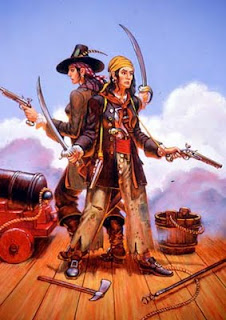 |
| Mary Reed and Anne Bonny |

Moll Cutpurse
I haven't watched the games, but watching the reaction to the U.S. women's soccer team has been inspiring. On the other side of the world, geographically and culturally, I saw a similarly inspiring story about increasing cell-phone usage by women in third-world nations, and how it is liberating and connecting them one at a time. An Afghan woman had enjoyed her phone to keep in touch with family, but her enraged husband took it and beat her, fearing loss of control. I'd like to turn that soccer team loose on him.
Traditionalists were probably upset over iconoclastic women like Katherine Hepburn and Marlene Dietrich wearing men's clothes, making their own rules and upsetting gender role preconceptions. They were in a position to get away with it, and did it with unassailable class. Others have taken a much lower road, in a colorful and outrageous manner; despite being attacked relentlessly by the religious establishment and the law, they did it their way.
When I did 18th century re-enacting, the women did a very good job of portraying all classes of conventional ladies, but there were in fact some woodswomen (like Ann Bailey and Mrs. Pentry) who abandoned the voluminous dress and the suffocating corset to find adventure in the wilderness. Mary Read and Anne Bonny had brief but intensely exciting careers as pirates (and quite competent ones) in the early 18th century; their actual fates are lost in myth, unfortunately. I'd like to think they got away with it.
In the Renaissance and later times, students and tavern carousers who brawled on the streets were called "Roaring Boys;" one woman who was immortalized as The Roaring Girl in a 1611 play, a 1662 biography and a 1985 novel surpassed them all in bad behavior. Mary Frith (ca. 1584 to ca. 1659) of England became known as Moll Cutpurse early on in a very successful career as a thief, pickpocket, fence and pimp. "Moll" is a nickname for Mary, and also means a disreputable young woman; gangster's "moll" is the only current usage. According to a contemporary history, she "was troubled with none of those longings which poor maidens are subject to." A tomboy from the beginning, she dressed in men's clothes and smoked a pipe ("a great many of her sex have followed her example," it was said). She married, but probably only as a legal ploy. Her greatest defeat of the law, however, was during her time as a highwayman when she robbed General Fairfax of "250 jacobuses," shooting him through the arm in the process. Her horse failed her in the escape and she was taken to Newgate Prison, but got out by giving the victim 2000 pounds. This may be mostly legend, but makes a good story that Errol Flynn should have filmed (now that would be gender confusion!).
She was a ham, also: Moll performed in a stage show in which she bantered, sang and played the lute; this was during a time when women did not act or perform in any public venue. That didn't stop her for a minute.
Moll would have liked our soccer team, I think.

Oh the stories I could tell. As if in all time the adventure is what matters.
ReplyDelete